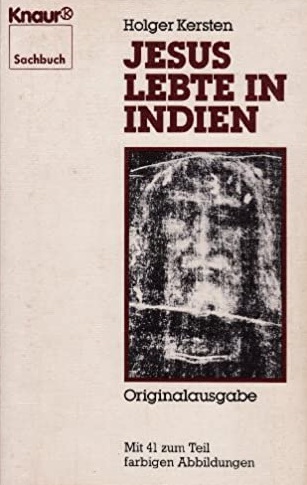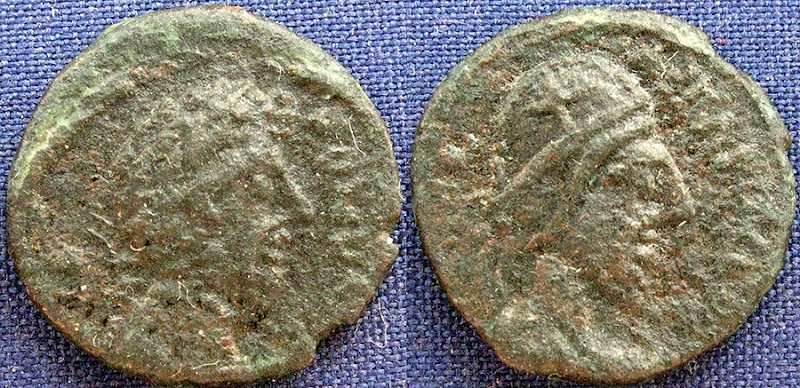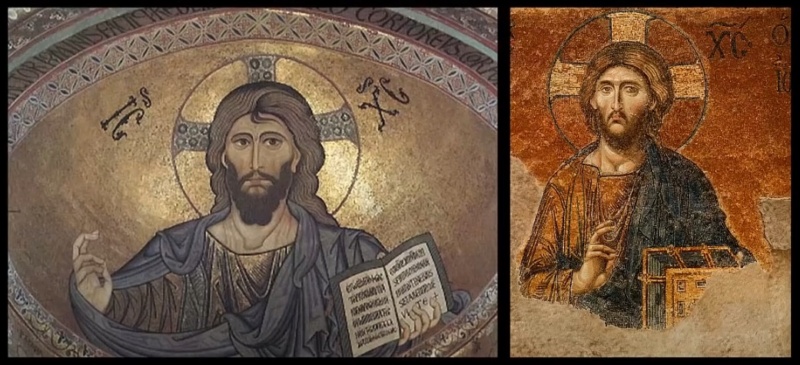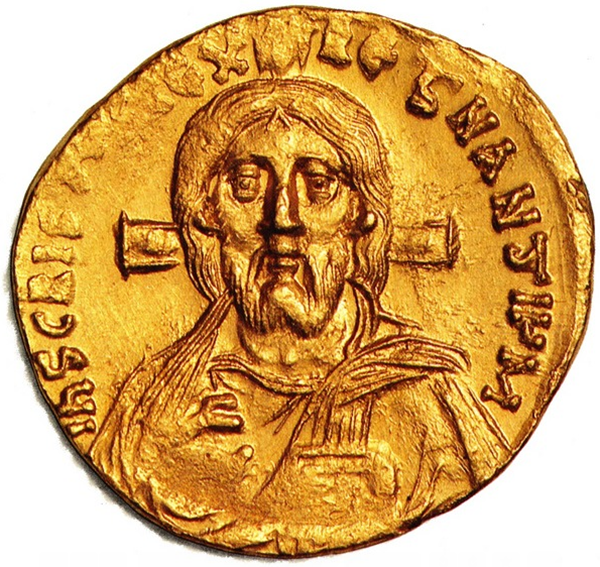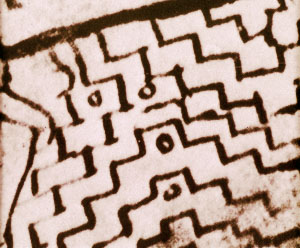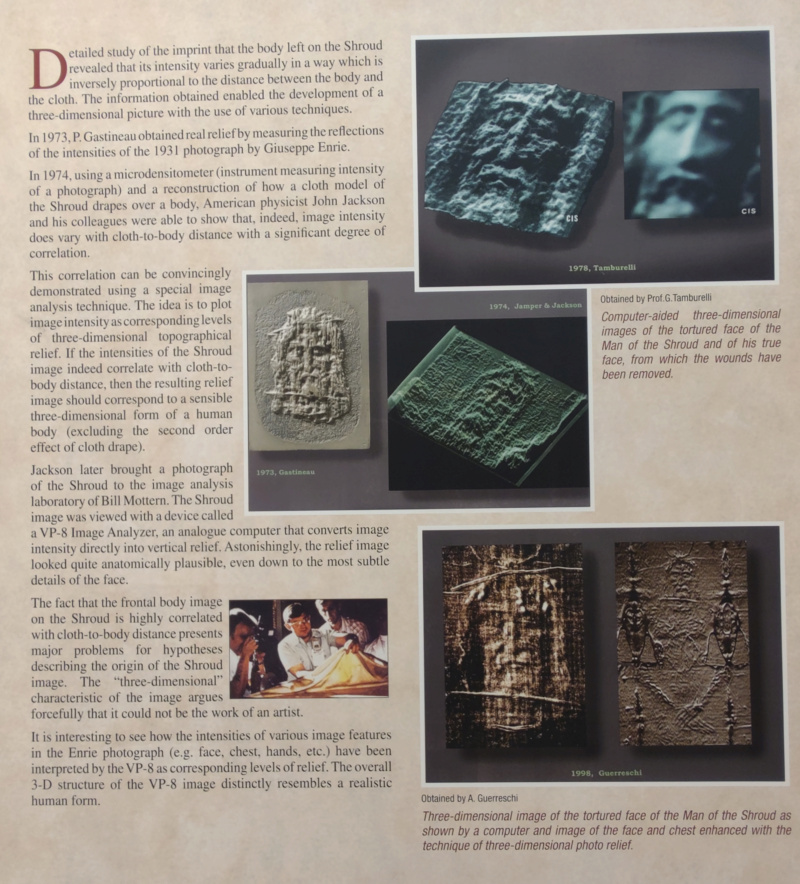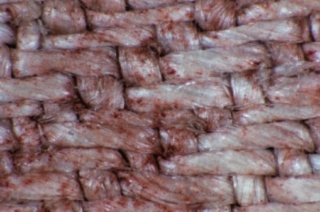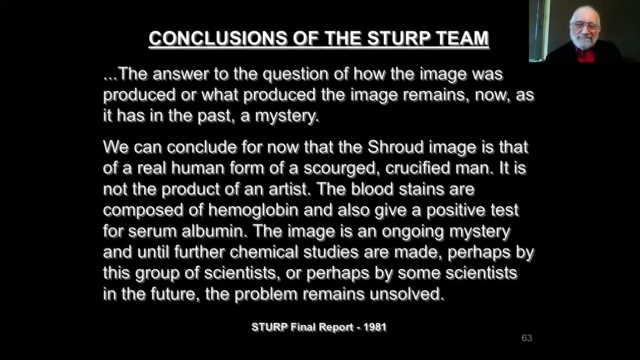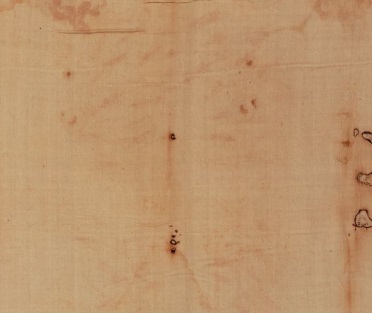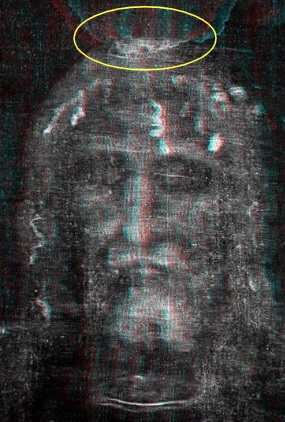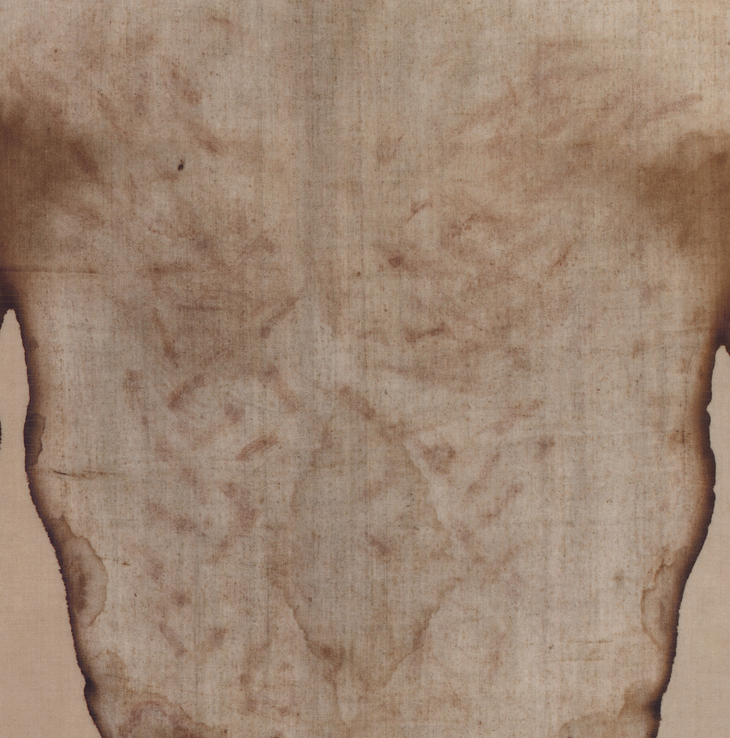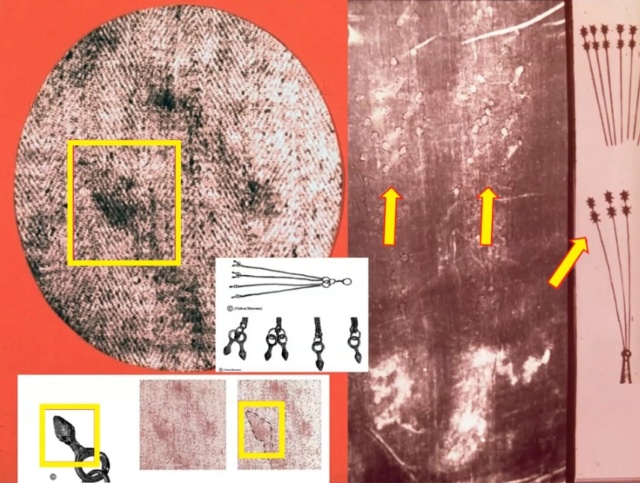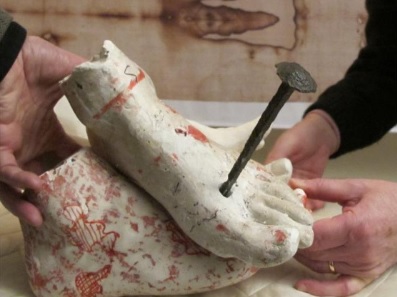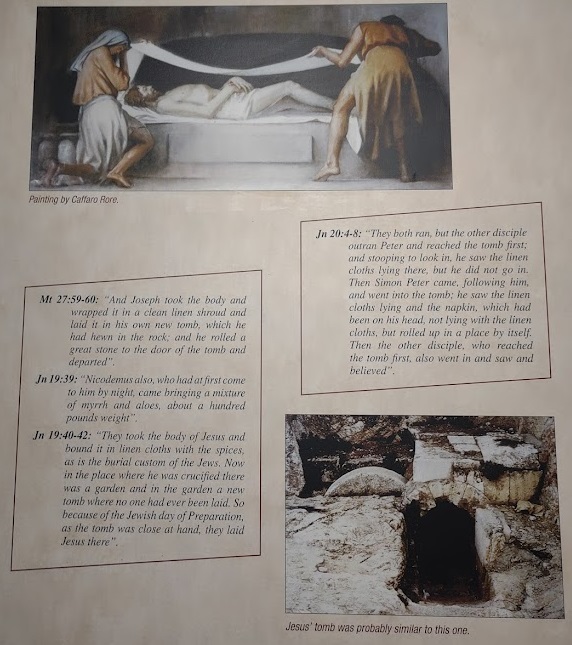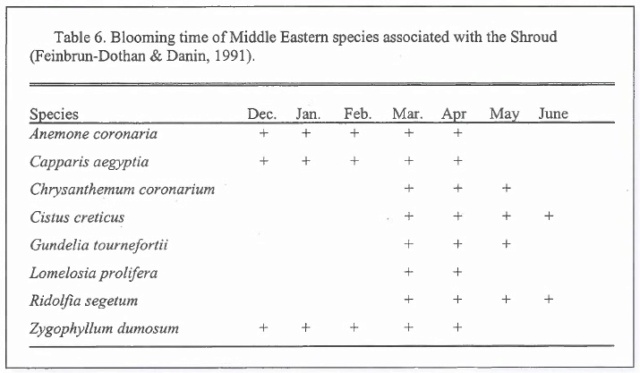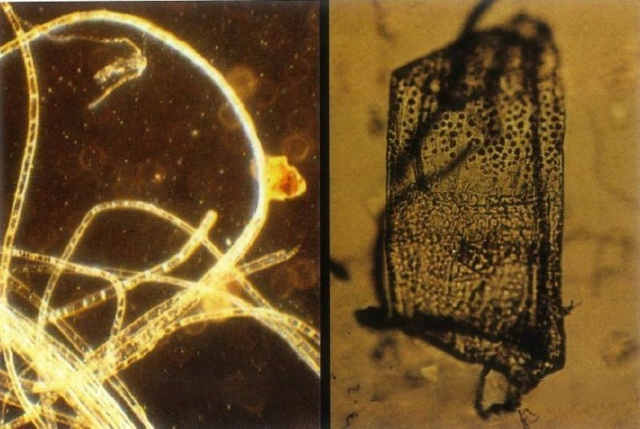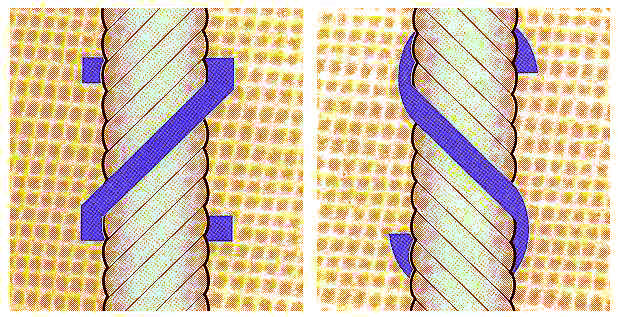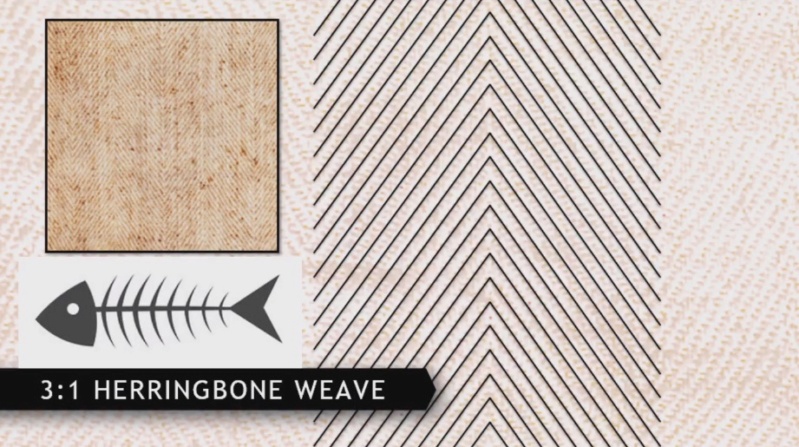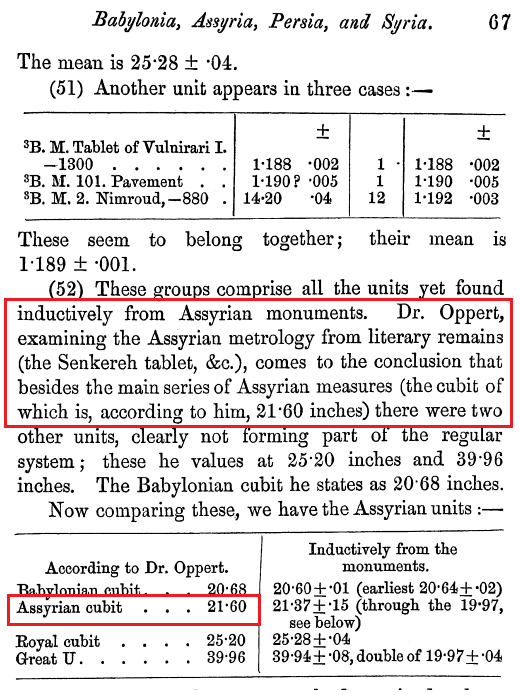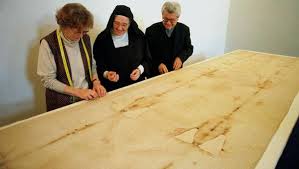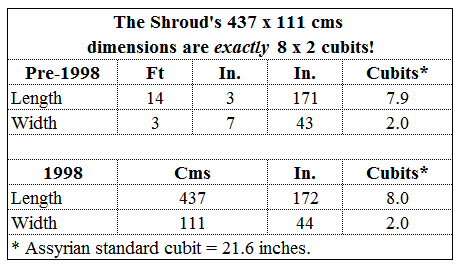https://reasonandscience.catsboard.com/t3268-confirming-jesus
The Shroud of Turin
Chronology of the Turin Shroud: AD 30 to the 14th. century
Overwhelming cumulative evidence substantiates that the Shroud of Turin is authentic!
Could the Shroud be a forgery?
Is the man on the shroud Jesus?
Commonly given reasons to be skeptical that the Shroud is authentic
How was the image made?
The Sudarium of Oviedo
The Radiocarbon dating of the Shroud
Botanical evidence on the Shroud of Turin
The Weave of the Shroud of Turin
The impossible faith
The historicity of Jesus
The Gospels are reliable stories, based on witness testimony
The book of Isaiah 53, and the dead sea scrolls
How did Jesus look like?
The genealogy of the messiah
Prophecies in the Old Testament confirming Jesus as the Messiah
Prophecy of Daniel’s Seventy Weeks – Daniel 9:24-27
The exact date of Christ’s crucifixion and death
Are the Gospels historically reliable?
Undesigned coincidences in the gospels
What are the main reasons that corroborate and confirm the resurrection of Jesus?
Who were the authors of the gospels and acts, and when were they written?
Evidence of authenticity, archaeology, and undesigned coincidences in the gospels: Matthew
The gospel of Luke

The historical evidence that substantiates Jesus historicity and Biblical identity
The God talk
https://www.youtube.com/channel/UC0nEzsU2UOrx1eXGw-Kjw4w?view_as=subscriber
The name of the messiah (Ha'Mashiyach) is Yahushua. YAHUSHA = YAHU + SHA. This in Hebrew means YAHUAH saves.
Introduction
The question about who Jesus is, is actual today, as it ever was in the last 2000 years. As someone that has extensively studied literature related to Christian origins and early Christianity, I have assembled a collection of quotes and excerpts from top scholars and books on the historicity of Jesus Christ. With this work, i present a comprehensive and clear picture that corroborates Jesus' biblical identity. This includes evidence such as fulfilled prophecies, archaeological findings, extra-biblical writings, nondesigned coincidences in the gospels, and the dating of the oldest manuscripts. Additionally, I compare the evidence to a symphonic orchestra where each individual musician contributes to the overall result of a partiture. Likewise, evidence for the historical existence of Jesus Christ comes from various sources such as history, archaeology, the Bible, Roman authors, and scientific faculties like those investigating the Shroud of Turin. The experts in these fields are the players, and my role is that of a composer and director bringing them together to solidify our faith and confirm Jesus as the long-awaited and rejected messiah of Israel.
Matthew 16.13 -17: When Jesus came to the region of Caesarea Philippi, he asked his disciples, “Who do people say the Son of Man is?” They replied, “Some say John the Baptist; others say Elijah; and still others, Jeremiah or one of the prophets.” “But what about you?” he asked. “Who do you say I am?” Simon Peter answered, “You are the Messiah, the Son of the living God.” Jesus replied, “Blessed are you, Simon son of Jonah, for this was not revealed to you by flesh and blood, but by my Father in heaven.
Peter confirmed that Jesus was the Son of the living God. The same question goes for you. Who do you believe Jesus was? You can either respond positively, that you believe in Christ as Lord, or you can deny it, and go even a step further, and argue that he never existed. C. S.Lewis wrote in Mere Christianity:
I am trying here to prevent anyone from saying the really foolish thing that people often say about Him: I'm ready to accept Jesus as a great moral teacher, but I don't accept his claim to be God. That is the one thing we must not say. A man who was merely a man and said the sort of things Jesus said would not be a great moral teacher. He would either be a lunatic — on the level with the man who says he is a poached egg — or else he would be the Devil of Hell. You must make your choice.

Either this man was, and is, the Son of God, or else a madman or something worse. You can shut him up for a fool, you can spit at him and kill him as a demon or you can fall at his feet and call him Lord and God, but let us not come with any patronizing nonsense about his being a great human teacher. He has not left that open to us. He did not intend to. ... Now it seems to me obvious that He was neither a lunatic nor a fiend: and consequently, however strange or terrifying or unlikely it may seem, I have to accept the view that He was and is God.

I cannot imagine and think of many more relevant questions. Either Jesus is a myth, a figure that was invented by someone, or a group of people, for some (spurious) reasons, that has deluded billions of people over 2000 years. He could also be a historical figure, but not God, and all claims in regard to the miracles reported in the gospels, and the resurrection, never happened. Or his claims are true, and he is divine, the long-awaited messiah in the Old Testament, the second person of the triune God, that has revealed himself in the Bible. If we respond negatively to Christ's calling, and he is indeed who he is said to be, we will spend eternity in hell. If we respond positively, we will spend eternity in heaven. If he is not who he is said to be, it doesn't matter if we believe in the claims made in the New Testament, it will have no consequences. We will all become inanimated matter. In recent times, there has been an increase in books and YouTube streams created by atheists who dispute the historicity of Jesus, even going so far as to question his existence as a historical figure, along with his resurrection and miracles. This book aims to address these issues by presenting a collection of evidence that substantiates the view that Jesus Christ is truly who he claimed to be: Lord, God, the second person of the triune God, the Messiah, and Savior.
There is an abundance of biblical and extra-biblical evidence that supports the claim that the Christian movement began in Judaea in the first century and spread rapidly across the Roman empire and beyond following Christ's crucifixion and resurrection. This growth was due to the credible and trustworthy narratives of the eyewitnesses of Jesus. It is my hope that while reading this book, you will experience moments of awe as the information contained within confirms powerfully how reliable and solid the narratives in the New Testament are. If you are an unbeliever, my wish is that you will find reasons to adopt the Christian worldview and receive Christ as your Lord and Savior. And if you are a believer struggling with doubts, this book can help remove them, allowing your faith to become as solid as a rock. The God of the Bible deserves our trust, faith, and obedience, and our lives should be built upon the foundation which is Christ.
The person, the man Jesus Christ, is well placed in human history. Born between 6 and 4BC, in the reign of Herod the Great (Wikipedia), and crucified in 1st-century Judea, most likely in AD 30 or AD 33. (Wiki) He came with a mission. Jesus demonstrated throughout His life that He was a man with a clear mission and purpose to fulfill. He recognized from a young age that He must prioritize His Father's will (Luke 2:49, KJV). As He neared the end of His earthly life, Jesus determinedly set out for Jerusalem, knowing that His death awaited Him there (Luke 9:51). The central aim of Jesus' time on earth can be understood as fulfilling God's plan to save the lost.
But why believe in Him? There are so many religions that contradict the Gospels.
Claim: Jesus is a myth
Response: While a small number of scholars, writers, and advocates hold the view that Jesus is a myth, there are several arguments that refute this claim. Firstly, the vast majority of historians and scholars who study the historical Jesus agree that he was a real person who lived in the first century AD, including both Christian and non-Christian scholars. Additionally, the Gospels were written while many eyewitnesses were still alive, making it less likely that the events were fabricated or exaggerated. Furthermore, other non-Christian sources, such as the Jewish historian Josephus and the Roman historian Tacitus, also refer to Jesus as a historical figure. The idea that Jesus was a myth would require a conspiracy theory involving numerous people over a long period of time, which is not supported by any plausible motive. Lastly, the Gospels include details that would have been embarrassing or inconvenient for early Christians if they were not true, suggesting that the Gospel writers were not simply making up a story to suit their own purposes. In conclusion, the consensus among experts is that Jesus was a real historical figure who had a significant impact on the world. While there may be some debate over the interpretation of certain details, the claim that Jesus is a myth is not supported by the majority of historical scholarship or the available evidence.
Books opposing Jesus Christ as an authentic historical figure, and his resurrection
Throughout history, there have been periods of radical skepticism towards the historicity of Jesus, with figures such as Bruno Bauer, Albert Kalthoff, and Arthur Drews cited as examples. These skeptics have questioned Jesus' existence as a historical figure, offering explanations such as Jesus being a product of literary imagination, social needs, or mythical traditions. However, it is important to note that skepticism exists both within and outside of theology, with skeptics often attempting to rob Christianity of its legitimacy or using it for their own purposes.
The appropriate historical evaluation of Christian sources remains a problem, with thirteen objections made by historical skeptics that suggest any historical evaluation of these sources is an impossible task. However, it is crucial to approach the study of Jesus with critical thinking, free from the pressure to legitimate faith or unbelief by the results of scholarship. While historical evaluation of Christian sources is a challenging task, it is not an impossible one, and scholarly discussion of Jesus should strive for freedom from the pressure of a single alternative approach.
The most common objections
Despite one's expectation, contemporary non-Christian sources, such as Philo of Alexandria, do not mention Jesus, which is known as the "silence" of non-Christian sources.
The letters of Paul, the earliest Christian writings, portray Jesus as a nearly mythical figure with a brief earthly existence, leading some to question whether there was any Synoptic tradition about Jesus in Paul's time.
There are irreconcilable differences, such as contradictions in chronology and the style of the revelation discourses, between the Synoptic and Johannine depictions of Jesus.
The Easter faith has fused post-Easter worship and historical recollection, creating an "Easter gulf" that makes it difficult to distinguish between them.
The Synoptic Gospels were written between forty and seventy years after Jesus' death, outside of Palestine and in Greek, which is not Jesus' native language or that of his earliest followers.
The Jesus tradition is kerygmatic, meaning it speaks to the present and has an interest in preaching, rather than preserving historical memories.
The Jesus tradition is shaped primarily by the context in which it was used (the 'Sitz im Leben'), leading to the reshaping of Jesus' image to the point of being unrecognizable.
The first Christians often interpreted memories of Jesus through the lens of the Old Testament and even created stories based on it, seeing it as more reliable than the testimony of human eyewitnesses.
New community formations were created based on the existing Jesus tradition, which was originally in the form of small units, making it difficult to distinguish between authentic traditions and new developments.
The logia tradition contains early Christian prophetic sayings spoken in the name of the exalted Christ, making it hard to distinguish from the words of the earthly Jesus.
Miracle stories contain typical motifs of the ancient belief in miracles, transforming historical recollection, and potentially transferring whole stories about Jesus without concrete basis.
The framework of the story of Jesus, including his birth, temptation, transfiguration, and resurrection, has been transformed with mythical motives, making it difficult to distinguish between historical events and mythology.
The criteria developed to define historical Jesus material are often one-sided and cannot reliably fulfill their purpose.
Claims that Jesus never existed
While doing research for this book, I was surprised to stumble upon a website by Kenneth Humphreys entirely dedicated to proving that Jesus never existed 1, with the subtitle: Exposing the tragic fabrication of a savior of the world. Claiming to have 8 million+ visitors on his website, and 20,000+ subscribers! and 5 million+ YT views! ( November 2022). Humphreys also wrote a book:
Kenneth Humphreys (2008): Jesus Never Existed.
Description: No "hidden code", no "secret bloodline", no "arcane wisdom", no "holy grail", in fact, no mystery at all – just the unembellished truth about the greatest fraud in history. Jesus Never Existed reveals a disturbing truth: that the triumph of Christianity was a disaster for humanity – made chillingly ironic by the bogus nature of its central character, superstar and "saviour". Jesus Never Existed is an uncompromising exposure of the counterfeit origins of Christianity and of the evil it has brought to the world. Not a book for those who wish to keep their faith in the cosy bliss of historical ignorance. Over 50 articles from this website, many revised and updated, arranged into ten chapters, each of which shakes Christianity to its very foundations.2
Michael Paulkovich (2013): No Meek Messiah: Christianity’s Lies, Laws and Legacy
Description:
Religious leaders generally spoon-feed their flock the few parts of the Bible that are not blatantly contradictory, nor evil, nor violent. The Bible is a very boring, very frightening, yet a very hilarious read. And the history of religious oppression is much more murderous than most people are aware. The book No Meek Messiah chronicles the cobbling of Christianity, its outrageous forgeries, and its immoral acts of torture, genocide, and obfuscation over the many centuries. The "virgin birth" tale was a forgery perpetrated 250 years before Jesus, even admitted by the Catholic Encyclopedia. No Meek Messiah exposes that Jesus believed in Noah's Ark, Adam & Eve, Jonah living in a fish or whale, and Lot's wife turning into salt. (Historian Josephus, often cited by Christians as proof of the historicity of Jesus, also claims that he as actually seen the "pillar of salt" that Lot's wife turned into; "for I have seen it, and it remains at this day," Josephus lied. Jesus even bought into the absurd notion (Jn 3:14) that a magical pole proffered by the OT (Num 21:9) could cure snakebites merely by gazing upon it. Only a very selective reading of the Bible can adduce the eternal assertion that Jesus was a perfect and saintly figure. Meek Jesus boasted he was "greater than Solomon, and that he "came not to send peace, but a sword," and "to send fire on the earth."
Jesus desperately needs your praise, and advises savage whipping for disobedient slaves. These are scriptures never mentioned at the typical sermon or Sunday school. This is merely the tip of Jesus' "meek" iceberg.
No Meek Messiah exposes the plethora of forgeries perpetrated by Christian leaders over the centuries, showing how the corrupt Church gained massive power and wealth. The many murders and witch hunts are also exposed in great detail. Michael Paulkovich, 2013. No Meek Messiah. Freelance writer and contributor to The American Rationalist, American Atheist Magazine and Free Inquiry presents one-hundred-and-twenty-six writers from the "time of Jesus" who should have, but did not record anything about the Christian godman 3
Response: Interestingly, in this entire rant, no line provides any evidence for the claim that Jesus never existed.
DailyMail (2014): However thought it was worth noticing the book. The reporter wrote: ‘"Jesus of Nazareth" was nothing more than urban (or desert) legend, likely an agglomeration of several evangelic and deluded rabbis who might have existed.’ Of the writings he examined, written from the first to third centuries, he found only one book that contained a mention of Jesus - The Jewish Wars by the Roman historian Josephus Flavius written in 95 CE, but he claims it is fabricated. Paulkovich says the mentions of Jesus were added later by editors, not by Josephus. Paulkovich’s views will surely prove very controversial, as most scholars do not support the theory that Jesus never existed.4
A prominent author, that frequently appears as a guest on atheist YouTube channels, to claim that the historical Jesus never existed, is Richard Carrier Ph.D. Wikipedia writes about him: Carrier has become a vocal advocate of the theory that Jesus was not a historical person He has published several books.
Richard Carrier Ph.D. (2012): Proving History: Bayes's Theorem and the Quest for the Historical Jesus.
Description: An essential work on historical methods: Almost all experts agree that the Jesus of the Bible is a composite of myth, legend, and some historical evidence. So what can we know about the real Jesus? For more than one hundred fifty years, scholars have attempted to answer this question. Unfortunately, the "Quest for the Historical Jesus" has produced as many different images of the original Jesus as the scholars who have studied the subject. The result is a confused mass of disparate opinions with no consensus view of what actually happened at the dawn of Christianity. In this in-depth discussion of New Testament scholarship and the challenges of history as a whole, historian Richard C. Carrier proposes Bayes's theorem as a solution to the problem of establishing reliable historical criteria. He demonstrates that valid historical methods—not only in the study of Christian origins but in any historical study—can be described by, and reduced to, the logic of Bayes's theorem. Conversely, he argues that any method that cannot be reduced to Bayes's theorem is invalid and should be abandoned. Writing with thoroughness and admirable clarity, Carrier explains Bayes's theorem in terms easily understandable to historians and laypeople alike, employing nothing more than well-known primary school math. He then explores the theorem's application to history and addresses numerous challenges to and criticisms of this application. Common historical methods are analyzed using the theorem, as well as all the major "historicity criteria" employed in the latest quest for the historical Jesus. The author demonstrates not only their deficiencies but also ways to rehabilitate them. Anyone with an interest in historical methods, epistemology generally, or the study of the historical Jesus will find Carrier's book to be an essential work.5
Response: While it is true that there is a lack of consensus among scholars about the historical Jesus, it is misleading to claim that "almost all experts" agree that the Jesus of the Bible is a composite of myth, legend, and some historical evidence. In fact, there are many scholars who argue that there is significant historical evidence for the existence of Jesus and the basic outline of his life and teachings. Furthermore, the claim that the "Quest for the Historical Jesus" has produced as many different images of the original Jesus as the scholars who have studied the subject is an oversimplification of the situation. The use of Bayes's theorem as a solution to the problem of establishing reliable historical criteria is also controversial. While the theorem can be a useful tool in certain situations, it is not universally applicable to historical research. The claim that any method that cannot be reduced to Bayes's theorem is invalid and should be abandoned is an extreme and unwarranted position. While Carrier's book may be a valuable contribution to the discussion of historical methods, it is important to recognize that his arguments are not universally accepted among scholars. The field of historical Jesus research is complex and multifaceted, and no single approach or methodology can provide definitive answers to all of the questions and challenges involved.
Richard Carrier Ph.D. et al., (2013): Bart Ehrman and the Quest of the Historical Jesus of Nazareth.
Description: When New Testament scholar Bart Ehrman published Did Jesus Exist? The Historical Argument for Jesus of Nazareth, he not only attempted to prove the historical reality of a man called “Jesus of Nazareth,” he sharply criticized scholars who have sought to develop a new paradigm in the study of Christian origins—scholars who have claimed that Jesus was a mythical, not historical, figure, and that the traditional, Jesus-centered paradigm for studying the origins of Christianity must be replaced by an actual science of Christian origins. In the present volume, some of those scholars respond to Ehrman’s treatment of their research and findings, showing how he has either ignored, misunderstood or misrepresented their arguments. They present evidence that “Jesus of Nazareth” was no more historical than Osiris or Thor. Several contributors question not only the historicity of “Jesus of Nazareth,” they present evidence that the site of present-day Nazareth was not inhabited at the time Jesus and his family should have been living there.6
Response: It is important to note that while there may be scholars who argue that Jesus was a mythical figure, the majority of scholars in the field of New Testament studies agree that a man named Jesus of Nazareth did exist. Bart Ehrman's book Did Jesus Exist? is one of many works that present evidence for the historical reality of Jesus. As for the claim that the site of present-day Nazareth was not inhabited at the time Jesus and his family should have been living there, it is important to consider the evidence presented by archaeologists and other scholars who have studied the region. While there may be some debate about the exact timeline of settlement in Nazareth, the consensus among scholars is that the town did exist during the time of Jesus.
Richard Carrier Ph.D. (2014): On the Historicity of Jesus: Why We Might Have Reason for Doubt.
Description: The assumption that Jesus existed as a historical person has occasionally been questioned in the course of the last hundred years or so, but any doubts that have been raised have usually been put to rest in favor of imagining a blend of the historical, the mythical and the theological in the surviving records of Jesus. Carrier re-examines the whole question and finds compelling reasons to suspect the more daring assumption is correct. He lays out extensive research on the evidence for Jesus and the origins of Christianity and poses the key questions that must now be answered if the historicity of Jesus is to survive as a dominant paradigm. Carrier contrasts the most credible reconstruction of a historical Jesus with the most credible theory of Christian origins if a historical Jesus did not exist. Such a theory would posit that the Jesus figure was originally conceived of as a celestial being known only through private revelations and hidden messages in scripture; then stories placing this being in earth history were crafted to communicate the claims of the gospel allegorically; such stories eventually came to be believed or promoted in the struggle for control of the Christian churches that survived the tribulations of the first century. Carrier finds the latter theory more credible than has been previously imagined. He explains why it offers a better explanation for all the disparate evidence surviving from the first two centuries of the Christian era. He argues that we need a more careful and robust theory of cultural syncretism between Jewish theology and politics of the second-temple period and the most popular features of pagan religion and philosophy of the time. For anyone intent on defending a historical Jesus, this is the book to challenge.7
Richard Carrier Ph.D. (2015): Jesus Did Not Exist: A Debate Among Atheists
Description: For a lay audience, and with help from historian Richard Carrier, religious studies scholar Raphael Lataster considers the best arguments for and against the existence of the so-called Historical Jesus; the Jesus of atheists. Parts 1 & 2 analyze the cases made by Bart Ehrman and Maurice Casey, who assert that Jesus definitely existed. Their arguments are found to be riddled with errors, and dependent on unreliable, and even non-existing, sources. Parts 3 & 4 discuss the more skeptical work of Lataster and Carrier, who conclude that Christianity probably began not with a humble carpenter, but with 'visions' of a heavenly Messiah.
This exciting collaboration makes it very clear why the Historical Jesus might not have existed after all, and, to those willing to adopt a commonsensical probabilistic approach, Jesus Did Not Exist.8
Response: The argument for Jesus' existence is not based solely on religious texts or beliefs, but is supported by a wide range of historical and archaeological evidence. For example, there are numerous non-Christian sources from the time period that refer to Jesus, including the writings of Josephus and Tacitus. The idea that Christianity began with "visions" of a heavenly Messiah is not supported by historical evidence. The earliest Christian writings, such as the letters of Paul, indicate that Jesus was a real person who lived and died on Earth. The idea of a heavenly Messiah did not emerge until later in the development of Christian theology. While there may be a few scholars who argue against the historicity of Jesus, their views are not widely accepted in the academic community. The overwhelming consensus among experts is that Jesus of Nazareth was a historical figure, and this view is supported by a wide range of historical and archaeological evidence.
The claim that Jesus was invented by the Romans
Joseph Atwill (2005): Caesar's Messiah: The Roman Conspiracy to Invent Jesus.
Description: Was Jesus the invention of a Roman emperor? The author of this ground-breaking book believes he was. "Caesar’s Messiah" reveals the key to a new and revolutionary understanding of Christian origins. The clues leading to its startling conclusions are found in the writings of the first-century historian Flavius Josephus, whose "Wars of the Jews" is one of the only historical chronicles of this period. Closely comparing the work of Josephus with the New Testament Gospels, "Caesar’s Messiah" demonstrates that the Romans directed the writing of both. Their purpose: to offer a vision of a “peaceful Messiah” who would serve as an alternative to the revolutionary leaders who were rocking first-century Israel and threatening Rome. Similarly, "Caesar’s Messiah" will rock our understanding of Christian history as it reveals that Jesus was a fictional character portrayed in four Gospels written not by Christians but Romans. This Flavian Signature edition adds Atwill’s latest discoveries of numerous parallel events in sequence which ultimately reveal the identity of the true authors of the Gospels.9
Response: The claim that Jesus was a fictional character portrayed in the Gospels written by Romans is not supported by mainstream scholarship or historical evidence. The idea that the Romans invented Jesus as a tool for political control is a fringe theory that lacks credible evidence. The historical consensus is that Jesus of Nazareth was a real historical figure who lived in first-century Palestine and was crucified under the Roman governor Pontius Pilate. While it is true that the writings of Josephus are an important historical source for the period, scholars generally do not see evidence of direct Roman control over the New Testament Gospels. Rather, the Gospels are seen as the product of early Christian communities who sought to convey their understanding of Jesus and his teachings. The hypothesis proposed in "Caesar's Messiah" has been widely criticized for relying on selective and speculative interpretations of both Josephus and the Gospels. The idea that Jesus was a fictional character created by the Romans does not stand up to the rigorous historical scrutiny that has been applied to the subject by scholars. The claim that Jesus was the invention of a Roman emperor is not a credible or widely accepted theory among historians and scholars of early Christianity.
James S. Valliant (2016): Creating Christ: How Roman Emperors Invented Christianity.
Description: Exhaustively annotated and illustrated, this explosive work of history unearths clues that finally demonstrate the truth about one of the world’s great religions: that it was born out of the conflict between the Romans and messianic Jews who fought a bitter war with each other during the 1st Century. The Romans employed a tactic they routinely used to conquer and absorb other nations: they grafted their imperial rule onto the religion of the conquered. After 30 years of research, authors James S. Valliant and C.W. Fahy present irrefutable archeological and textual evidence that proves Christianity was created by Roman Caesars in this book that breaks new ground in Christian scholarship and is destined to change the way the world looks at ancient religions forever. Inherited from a long-past era of tyranny, war and deliberate religious fraud, could Christianity have been created for an entirely different purpose than we have been lead to believe? Praised by scholars like Dead Sea Scrolls translator Robert Eisenman (James the Brother of Jesus), this exhaustive synthesis of historical detective work integrates all of the ancient sources about the earliest Christians and reveals new archeological evidence for the first time. And, despite the fable presented in current bestsellers like Bill O’Reilly’s Killing Jesus, the evidence presented in Creating Christ is irrefutable: Christianity was invented by Roman Emperors.10
Response: Lack of evidence: The authors of "Creating Christ" claim to present "irrefutable archaeological and textual evidence" for their argument, but in fact, there is a lack of concrete evidence to support their theory. The evidence for the origins of Christianity is complex and subject to interpretation, and there is no clear evidence of Roman manipulation or invention of the religion.
Historical context: The authors of "Creating Christ" argue that the Romans routinely employed the tactic of grafting their imperial rule onto the religion of the conquered, but this oversimplifies the complex historical context in which Christianity emerged. The origins of Christianity are rooted in the complex interplay of Jewish and Greco-Roman cultures, and the religion emerged over a period of several centuries, not as a result of a single imperial decree.
Early Christian literature: The authors of "Creating Christ" ignore or dismiss the vast body of early Christian literature that contradicts their theory, including the New Testament and the writings of early Christian theologians such as Ignatius of Antioch and Justin Martyr. These sources provide a rich and nuanced picture of the early Christian movement, and they do not support the idea that Christianity was created by Roman Caesars.
Lack of motive: The authors of "Creating Christ" fail to provide a convincing motive for why the Romans would create Christianity. While it is true that the Romans employed various tactics to maintain their imperial control, there is no clear reason why they would invent a new religion, especially one that initially posed a threat to their authority.
Henry Davis (2018): Creating Christianity - A Weapon Of Ancient Rome
A profound and controversial investigation of a complex theme - the war that led to the fall of Jerusalem and the creation of the Christian religion. The religious and political battle between the people of Judea and the Jewish and Roman aristocracies is presented in an unconventional narrative, which investigates ancient evidence, quotes from the work of respected authorities on the subject, and states controversial opinions openly. Its main conclusion is that the New Testament (the new law) was created by a powerful senatorial family called the Calpurnius Pisos, who had the full support of their relatives, the Herodian royal family (the family of ‘Herod the Great’), and the Flavian emperors, with the Piso family hiding their name within the Koine Greek scriptures. The result is a book that is both provocative and compelling. Using valuable feedback from Cambridge and Oxford University professors, Henry Davis explains why the supposed Jewish Historian, Flavius Josephus, never existed, how the Book of Revelation presents the name of the Piso family member who oversaw the creation of the Christian scripture, and the reason the number 666 was changed to 616. Davis also explains the facts behind the personal and political reasons that led to the Roman and Jewish royal families creating a new religion, and how the Piso family used the literary techniques of the aristocracy to insert their names into the scriptures. '... Anyone with a knowledge of the history of the Roman Empire knows that its conversion from a pagan belief system to widespread Christianity was a significant political and military move for the Empire as much as it was a religious decision, and this book focuses on the specific details and clues as to how that really came about. Davis searches for the real identity of the Christian Messiah and argues for a potentially Roman author of the modern NewTestament, one who had a view to creating a new religion for his own reasons as much as those of Rome.
Response: While there is ongoing debate among scholars about the origins of Christianity, the claim that it was created by a powerful senatorial family called the Calpurnius Pisos is not supported by mainstream scholarship. The idea that the Piso family hid their name within the Koine Greek scriptures is also not supported by evidence. Many scholars agree that the New Testament was written by a variety of authors over a period of several decades, and while there are some common themes and motifs, it is unlikely that it was the work of a single-family or individual. The idea that the Book of Revelation presents the name of a Piso family member who oversaw the creation of the Christian scripture is not supported by the vast majority of scholars. The number 666 being changed to 616 is also a matter of debate among scholars, with different theories about its origin. The claim that Flavius Josephus never existed is not supported by historical evidence. Josephus was a well-known Jewish historian and scholar who wrote extensively about the Jewish-Roman War and other historical events in the first century. While it is true that the conversion of the Roman Empire to Christianity was a significant political and military move, the claim that it was a deliberate creation of the Piso family for their own personal and political reasons is not supported by historical evidence. The origins of Christianity are complex and multifaceted, and there is no single theory that can fully explain its development.
Christ myth theory
Wikipedia: The Christ myth theory, also known as the Jesus myth theory, Jesus mythicism, or the Jesus ahistoricity theory, is the view that "the story of Jesus is a piece of mythology", possessing no "substantial claims to historical fact"11
David Fitzgerald (2017): Jesus: Mything in Action.
Description: David Fitzgerald’s award-winning 2010 book Nailed: Ten Christian Myths That Show Jesus Never Existed At All pointed out the top ten fatal flaws of Christianity’s origin story. Now, Jesus: Mything in Action presents the most compelling new findings in Jesus Myth theory and critically examines its controversial reception by biblical scholars, the extent and reliability of our sources for Jesus, and reveals the surprising history behind Jesus’ evolution.
In this volume: Mything in Action, vol. I (chapters 1 – 12) looks at the myths of Jesus Mythicism: what it is and isn’t; what biblical scholars are saying about it (and why); and examines our oldest “biographical” source for Jesus – the allegorical story we know as the Gospel of Mark.
Response: While there may be some debate among scholars about the historical existence of Jesus, the majority of biblical scholars and historians accept the existence of a historical figure named Jesus. The evidence for his existence comes not only from Christian sources but also from non-Christian sources such as the Jewish historian Josephus and the Roman historian Tacitus. The Gospels cannot be dismissed as mere myths. While they do contain theological elements and may have been written with a certain audience in mind, they also contain details that would be difficult to explain if Jesus were entirely mythical. For example, they include specific details about the geography, politics, and culture of the time period in which Jesus lived, as will be outlined in this work.
Calvin Smith (2020): The Jesus Myths: How a religious zealot created the fiction of Jesus and thus the New Testament.
Description: Many books and articles have been written contending that Jesus is a myth, and so he is, but they all stop short of revealing how and why the stories of Jesus came into being - which is the main subject of this book. If you doubt that anyone could write such an incredible tale - a story that occupies a major portion of the New Testament - think for a moment about the legend of Harry Potter. If JK Rowling had written that series of fables in the first century AD, we'd likely all be worshiping Harry today. But there's more than just Jesus fables to this book: Jean Messlier, a catholic priest for thirty years proves conclusively that God does not, and never did exist other than in the imaginations of men; instilled there by the insane mutants in the upper echelons of the Roman Catholic Church. Not only did the Popes and Bishops consistently murder each other, but one: Pope Stephan VI dug up the remains of his predecessor, Pope Formosus, and put his corpse on trial in what is known as the Cadaver Synod in the year 897AD. Formusus didn't say a word in his own defense and was therefore convicted.There are many other twists and turns in this book that make it a must for every bookshelf.
Response: The comparison to the Harry Potter series is not a valid one, as the historical context and evidence for Jesus' existence are vastly different from those of a fictional character. As for the claims about the Catholic Church and the existence of God, these are separate issues that also require critical evaluation and examination of the evidence presented. It is important to approach such claims with a skeptical and informed perspective.
R. P. Oliver (1998): Christianity is a fusion of two myths. The Jesus myth requires no explication. It is clear that the stories collected in the “New Testament” are versions of a folk-tale formed, like the legend of Robin Hood, by the accretion around a central figure of episodes in the careers of a number of minor figures. The Jesus of that legend was a composite formed from tales about Jesus ben Ananias,'Jesus ben Panderaf the agitator, whose name may have been Jesus, who led a party of his followers into Jerusalem during the celebration of the Passover and was well received by the populace, but soon suppressed, and Judas the Gaulanite3. And it is possible, of course, that there was an otherwise forgotten Jesus who also tried to start a Jewish revolt against civilized rule and paid the penalty. The composite Jesus was, of course, a would-be christ and interested only in his own barbarous people. The stories in the “New Testament” have been embellished by Christians, and that is what is remarkable.12
Response: While it is true that there are various myths and legends surrounding Jesus, it is a gross oversimplification to reduce Christianity to a mere fusion of folk-tales. The origins of Christianity are complex and multifaceted, involving not only the stories of Jesus but also the teachings and writings of his disciples and early Christian communities. Additionally, the claim that Jesus was interested only in his own people and was a would-be messiah ignores the fact that Jesus' message of love and compassion transcended ethnic and national boundaries, and that his teachings have had a profound impact on people of diverse backgrounds and cultures throughout history. Furthermore, the idea that the stories in the New Testament were embellished by Christians is a broad assertion that ignores the rich textual and historical evidence supporting the authenticity of the New Testament documents. While it is important to critically examine and understand the origins of Christianity, reducing it to a mere amalgamation of myths oversimplifies a complex and nuanced historical phenomenon.
Christ as a conspiracy
D.M. Murdock (1999): The Christ Conspiracy: The Greatest Story Ever Sold
Description: Contrary to popular belief, there was no single man at the genesis of Christianity but rather many characters rolled into one. The majority of these characters were personifications of the ubiquitous solar myth as reflected in the stories of such popular deities as Mithra, Hercules, Dionysus, and numerous others borrowed from Roman mythology and beyond. The story of Jesus as portrayed in the Gospels resembles those of the earlier savior gods Krishna and Horus. These redeemer tales are similar not because they reflect the actual exploits of a variety of men who did and said similar things but because they represent the same ancient core of knowledge that revolved around the celestial bodies and natural forces called Astrotheology. In this highly controversial and explosive book, archaeologist, linguist, and mythologist Acharya S/D.M. Murdock marshals an enormous amount of startling evidence to demonstrate that Christianity and the story of Jesus Christ were created by members of various secret societies, mystery schools and religions to unify the Roman Empire under one state religion. Through such fabrication, this multinational cabal drew on a multitude of myths and rituals that existed long before the Christian era, reworking them over centuries into the story and religion passed down today.
Response: The idea that Christianity was created by combining various pre-existing myths and legends is a theory that has been debated among scholars for many years. While it is true that there are similarities between the stories of Jesus and other religious figures, it is important to note that this does not necessarily mean that one story was borrowed from another. Many cultures throughout history have had stories about savior figures, and it is not uncommon for these stories to share certain themes and motifs. The idea that Christianity was created by secret societies and mystery schools to unify the Roman Empire under one state religion is also highly controversial and lacks strong evidence. While it is true that Christianity became the dominant religion of the Roman Empire, there were many factors that contributed to its rise, including the conversion of Emperor Constantine and the efforts of early Christian leaders to spread their message throughout the empire.
Jesus - borrowed from the pagans?
Arthur Drews (1998): Drews shows that Christianity is a syncretism of various pagan and Jewish beliefs and that a strong pre-Christian cult of Jesus as the son of God and messiah existed. This is a valuable sourcebook for students of religion, and all those interested in examining the origins of Christianity.13
Response: while Drews' work may provide interesting insights into the historical origins of Christianity, his theory that Jesus was purely mythical and that early Christian beliefs were entirely syncretic has been widely debated and challenged by scholars of religion and history. Many scholars argue that the existence of a historical Jesus is supported by a wealth of evidence from various sources, including the New Testament, early Christian writings, and non-Christian historical accounts. Additionally, while Christianity may have been influenced by various pagan and Jewish beliefs, it is not accurate to say that it is purely a syncretic religion. Christianity has its own unique beliefs, practices, and traditions that have evolved over time, and its origins cannot be reduced to a simple syncretism of other religions. As with any scholarly work, it is important to approach Drews' theories with a critical and open mind, and to consider multiple perspectives and sources of evidence.
Tim Freke (2000): The Jesus Mysteries: Was The Original Jesus A Pagan God?
Description: This groundbreaking book looks at one of the greatest cover-ups in history and dares to think the unthinkable about Christianity – that it was in fact a Jewish Mystery School modeled on the ancient Pagan Mysteries.
The myth of Dionysus bears startling resemblances to the story of Jesus Christ. It compares with the biblical story in the following ways:
• Dionysus is God made flesh and is hailed as the ‘Saviour of Mankind’ and the ‘Son of God
• His father is God and his mother is a mortal virgin who afterward becomes worshipped as the ‘Mother of God’
• He is born in a cowshed
• He drives out demons, turns water into wine and raises people from the dead
• He rides triumphantly into town while people wave palms to honor him
The date revered by the first Christians as Jesus’ birthday was originally that of Dionysus, also the three-day Spring Festival of Dionysus celebrating his death and resurrection coincides with the Christian festival of Easter. The last Supper and the Eucharist are also parallel Dionysian rites. This is not common knowledge as the story was a closely guarded secret of the Pagan mysteries. Secondly, the evidence of Christianity’s pagan roots were systematically covered up by the Roman Church.14
Response: While there are some similarities between the myth of Dionysus and the story of Jesus Christ, that correlation does not necessarily equal causation. Just because two stories share some common elements does not mean that one directly influenced the other. Consider the historical context in which Christianity emerged. While there may have been pre-existing beliefs and traditions that influenced the development of Christianity, it is unlikely that it was simply a copy-and-paste job of earlier religions. Christianity emerged in a specific time and place, with its own unique set of historical, cultural, and social factors that shaped its development. The idea that Christianity was a "Jewish Mystery School modeled on the ancient Pagan Mysteries" is not supported by mainstream scholarship. While there may have been some borrowing of ideas and practices, Christianity started from a specific Jewish context and developed its own unique beliefs and practices over time.
https://www.str.org/w/jesus-mythicist-finds-no-evidence-jesus-existed-after-excluding-evidence-he-existed
https://earlychurchhistory.org/christian-symbols/why-pollen-on-the-shroud-of-turin-proves-it-is-real/
https://whyevolutionistrue.com/2012/04/20/carrier-finally-responds-to-ehrman-on-the-historicity-of-jesus/
https://www.history.com/news/inside-the-conversion-tactics-of-the-early-christian-church
1. Kenneth Humphreys: Jesus Never Existed. 2008
2. Kenneth Humphreys: Jesus Never Existed: An Introduction to the Ultimate Heresy October 30, 2014
3. Michael Paulkovich : No Meek Messiah: Christianity’s Lies, Laws and Legacy 2013
4. JONATHAN O'CALLAGHAN FOR MAILONLINE: 'Jesus NEVER existed': Writer finds no mention of Christ in 126 historical texts and says he was a 'mythical character' 2 October 2014
5. Richard Carrier Ph.D.: Proving History: Bayes's Theorem and the Quest for the Historical Jesus. 2012
6. Richard Carrier Ph.D.: et.al., : Bart Ehrman and the Quest of the Historical Jesus of Nazareth. 2013
7. Richard Carrier: On the Historicity of Jesus: Why We Might Have Reason for Doubt 2014
8. Richard Carrier Ph.D.: Jesus Did Not Exist: A Debate Among Atheists 2015
9. Joseph Atwill: Caesar's Messiah: The Roman Conspiracy to Invent Jesus. 2005
10. James S. Valliant: Creating Christ: How Roman Emperors Invented Christianity. 2016
11. Wikipedia: Christ myth theory
12. Revilo Pendleton Oliver: Reflections on the Christ Myth 1998
13. Arthur Drews: The Christ Myth 1910
14. Tim Freke: The Jesus Mysteries: Was The Original Jesus A Pagan God? 2000
Last edited by Otangelo on Tue Dec 26, 2023 11:38 am; edited 90 times in total






